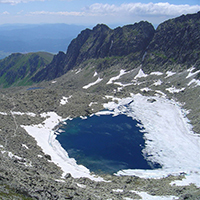Classification of the Tatra Mountain lakes in terms of the duration of their ice cover (Poland and Slovakia)
Ice cover classification of the Tatra Mountain lakes

All claims expressed in this article are solely those of the authors and do not necessarily represent those of their affiliated organizations, or those of the publisher, the editors and the reviewers. Any product that may be evaluated in this article or claim that may be made by its manufacturer is not guaranteed or endorsed by the publisher.
Authors
This paper presents the results of a classification of the Tatra lakes based on the duration of their ice cover, altitude, volume, and potential incoming solar radiation (PISR). It is embedded in the context of the impact of current climate change on the mountain environment. A digital elevation model, morphometric data, satellite imagery from the winter seasons of 2015-2017 and the Wrocław taxonomy method were used in the study. It was found that the order of freezing and thawing of the lakes investigated may change from year to year. The relationship between ice cover duration and altitude is clearly weakened by variations in lake volumes, with insolation having a noticeably lesser effect. Determining the duration of ice cover of the lakes over several seasons facilitates identifying the similarities and dissimilarities between them. Five groups of lakes displaying similar characteristics were identified as well as 2 groups of lakes with highly individual characteristics. Based on the data obtained, it can be concluded that the duration of ice cover on the Tatra lakes has been shortening noticeably over the last 100 years. Small high-altitude lakes seem to be most vulnerable to climate change.






